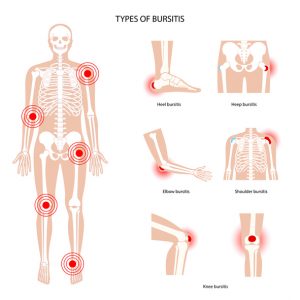Synovial Tissue Damage
Synovial tissue is a connective membrane that helps keep the synovial joints (hips and knees) healthy and lubricated. Not only does the synovium (another term for the synovial membrane) provide lubrication, but it also helps preserve the protective cartilage covering the joint surfaces. Synovitis is a condition that occurs when the synovial tissue becomes swollen and inflamed which, in turn, causes pain and other symptoms in the affected joint.
The knee is one of the most complex synovial joints in the body and is at high risk for developing painful synovitis. Keep reading to learn more about the signs of synovitis and what you can do to treat it.
What Causes Synovial Tissue Damage?
Synovial tissue damage in the knee is commonly caused by the following factors:
Inflammatory disease: synovitis frequently occurs in the setting of inflammatory conditions like rheumatoid arthritis, lupus, gout, and psoriatic arthritis.
Joint overuse: repetitive motions (like squatting) can lead to the synovial tissue becoming swollen and inflamed.
Nonsurgical Treatments
Any treatment plan will begin with conservative measures. The goals of treatment are to relieve pain, improve knee function, and prevent the condition from progressing any further. This could include:
- Anti-inflammatory medications to relieve pain and inflammation
- Antirheumatic drugs (depending on the underlying cause)
- Cold compression therapy
- Periods of rest and elevation
- Physical therapy to strengthen the knee
- Corticosteroid injections
Regular, low-impact exercise and stretching
If conservative treatments aren’t effective, surgery may be the next step.
Signs and Symptoms of Synovial Tissue Damage
The synovium plays a large role in ensuring your joints move smoothly and without friction. Damage to the synovial tissue can lead to significant pain and joint dysfunction in the knee. Common symptoms include:
- Joint pain
- Swelling and tenderness
- Stiffness
- Locking of the knee
- Painful mobility
The symptoms of synovial tissue damage look a lot like the symptoms of other common knee conditions. Therefore, it’s important to see a doctor for an accurate diagnosis.
Diagnosing Synovial Tissue Damage
During the diagnostic process, the doctor will ask you questions about specific symptoms and daily activities, personal medical history, and family medical history. They will also perform a physical exam to evaluate for pain and test range of motion. Finally, imaging tests like an X-ray or MRI will be performed.
If the doctor believes synovitis is caused by an underlying inflammatory condition, they may refer you to a rheumatologist for further evaluation.
When Is Surgery Necessary?
If severe synovial tissue damage is unresponsive to conservative treatment, a surgical procedure to remove the inflamed tissue can help relieve pain and improve knee function. This type of minimally invasive surgery is performed with the use of an arthroscope, a flexible tube with a camera, light, and other surgical instruments that are inserted into the affected joint. The procedure is usually performed on an outpatient basis, meaning you can return home the same day.
Reach Out to BEST Health System Today
If you’re living with knee pain, call BEST Health System today. We can connect you to a location near you and from there, our highly skilled medical team will help you develop a personalized treatment plan to get you back to the people and activities you love as soon as possible.
If you have experienced any of these symptoms or recieved a diagnosis and need treatment, BEST can help. Take the first step towards relief today.
Related Articles
A Map of BEST Health System's Ohio Locations
BEST – The Health System Redefining Care Throughout Ohio BEST Health System is a modern healthcare system with accessible locations throughout the state of Ohio. […]
Getting Rid of Knee Pain
Knee pain affects many people and there are several different causes and conditions that induce these symptoms. Living with knee pain can be debilitating and […]
What is Knee Replacement Surgery
The Causes of Knee Pain With age, knee pain becomes a common health condition that many adults suffer from. What begins as minimal, infrequent pain […]
5 Things You Didn't Know about Joint Care
Joint pain can be caused by a number of different conditions, the most prevalent being arthritis. If it is severe it can keep your day-to-day […]
Patient Testimonial - Mr. Roberts Total Knee Replacement
Living with Arthritis in the Knee What is it really like living with arthritis of the knee? As a patient, understanding what arthritis of the […]
Total Knee Arthroplasty with Dr. James Abbott
Living with Arthritis of the Knee What is it really like living with arthritis of the knee? To begin, it’s important to fully understand what […]
How Iovera Can Help Patients
What is Iovera Treatment? At BEST, our primary goal is to ensure our patients are at ease during each step of their treatment. Whether this […]
Why You Should Not Ignore Knee Pain
Are You Experiencing Persistent Knee Pain? If you have been dealing with chronic knee pain for a prolonged period, it is vital to take the […]
Osteoarthritis and Spinal Stenosis
What is Osteoarthritis Osteoarthritis is one of the most common causes of spinal stenosis, according to the American College of Rheumatology. Further research shows that […]
What Are the Most Common Causes of Meniscus Tears?
Meniscus tears are a common injury that results in pain and mobility problems for all kinds of people. Although it is often a sports injury, […]
Is it Time to Consider ACL Surgery? Watch Out for These Signs
movement changes or direct trauma to the knee through collision. This is why ACL tears are so common among football players, basketball players, and soccer players.
Five Major Types of Bursitis and How to Find Relief
Bursitis may not be as commonly known as arthritis, but it is just as difficult and debilitating to live with. This condition is similar to […]











